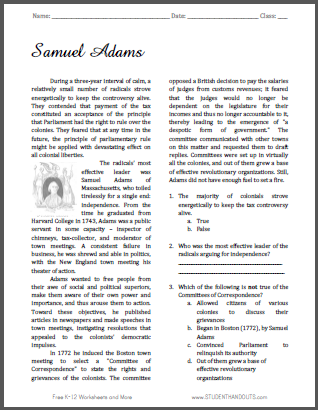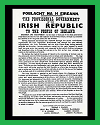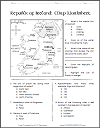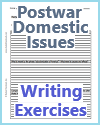Samuel Adams |
|
The radicals' most effective leader was Samuel Adams of
Massachusetts, who toiled tirelessly for a single end:
independence. From the time he graduated from Harvard College in
1743, Adams was a public servant in some capacity – inspector of
chimneys, tax-collector, and moderator of town meetings. A
consistent failure in business, he was shrewd and able in
politics, with the New England town meeting his theater of
action. Adams wanted to free people from their awe of social and
political superiors, make them aware of their own power and
importance, and thus arouse them to action. Toward these
objectives, he published articles in newspapers and made
speeches in town meetings, instigating resolutions that appealed
to the colonists' democratic impulses. In 1772 he induced the Boston town meeting to select a
"committee of Correspondence" to state the rights and grievances
of the colonists. The committee opposed a British decision to
pay the salaries of judges from customs revenues; it feared that
the judges would no longer be dependent on the legislature for
their incomes and thus no longer accountable to it, thereby
leading to the emergence of "a despotic form of government." The
committee communicated with other towns on this matter and
requested them to draft replies. committees were set up in
virtually all the colonies, and out of them grew a base of
effective revolutionary organizations. Still, Adams did not have
enough fuel to set a fire. Questions with answers in bold: 1. The majority of colonials strove energetically to keep the tax controversy alive. |
Click here to print. |
Text courtesy of the U.S. State Department,
Bureau of International Information Programs, 2005 |


 During a three-year interval of calm, a relatively small
number of radicals strove energetically to keep the controversy
alive. They contended that payment of the tax constituted
an acceptance of the principle that Parliament had the right to
rule over the colonies. They feared that at any time in the
future, the principle of parliamentary rule might be applied
with devastating effect on all colonial liberties.
During a three-year interval of calm, a relatively small
number of radicals strove energetically to keep the controversy
alive. They contended that payment of the tax constituted
an acceptance of the principle that Parliament had the right to
rule over the colonies. They feared that at any time in the
future, the principle of parliamentary rule might be applied
with devastating effect on all colonial liberties.









